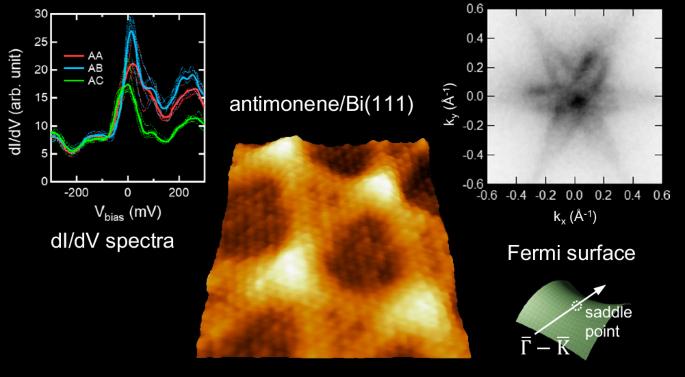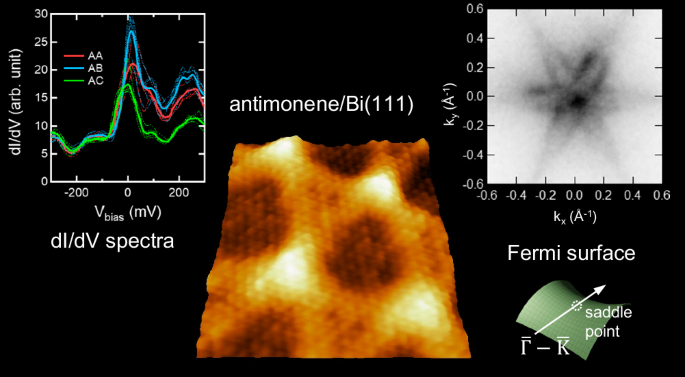具有范霍夫奇异性和拉什巴型自旋极化的 Bi(111) 衬底上的锑莫埃超晶格
IF 9.6
Q1 MATERIALS SCIENCE, MULTIDISCIPLINARY
引用次数: 0
摘要
由二维材料组成的莫伊里超晶格因其出现的平带诱导莫特绝缘态和非常规超导等现象而备受关注。然而,自旋轨道耦合对这些材料的影响尚未得到充分探索。在这里,我们展示了单层和双层锑蜂窝晶格(被称为锑烯)由于晶格失配而在 Bi(111) 衬底上形成摩尔超晶格。扫描隧道显微镜(STM)测量显示费米级附近存在光谱峰,这些光谱峰随摩尔纹周期发生空间调制。角度分辨光发射光谱(ARPES)与密度泛函理论计算相结合,阐明了费米级附近具有鞍点的表面带状结构,从而使我们能够将观察到的 STM 光谱峰归因于范霍夫奇点。此外,自旋分辨 ARPES 测量显示,观察到的表面态是拉什巴型自旋极化。本研究的重要意义在于,费米表面不稳定性和对称性破坏可能会在低温下出现,而自旋自由度和电子相关性在低温下也起着重要作用。莫伊里超晶格具有重要的基础研究意义,因为它们可以承载平带诱导的莫特绝缘态和非常规超导等新现象。本文通过 STM 和自旋分辨 ARPES 测量显示,Bi(111) 衬底上的二维锑蜂窝晶格形成了具有拉什巴型自旋极化态的摩尔超晶格。本文章由计算机程序翻译,如有差异,请以英文原文为准。


Moiré superlattices of antimonene on a Bi(111) substrate with van Hove singularity and Rashba-type spin polarization
Moiré superlattices consisting of two-dimensional materials have attracted immense attention because of emergent phenomena such as flat band-induced Mott insulating states and unconventional superconductivity. However, the effects of spin-orbit coupling on these materials have not yet been fully explored. Here, we show that single- and double-bilayer antimony honeycomb lattices, referred to as antimonene, form moiré superlattices on a Bi(111) substrate due to lattice mismatch. Scanning tunnelling microscopy (STM) measurements reveal the presence of spectral peaks near the Fermi level, which are spatially modulated with the moiré period. Angle-resolved photoemission spectroscopy (ARPES) combined with density functional theory calculations clarify the surface band structure with saddle points near the Fermi level, which allows us to attribute the observed STM spectral peaks to the van Hove singularity. Moreover, spin-resolved ARPES measurements reveal that the observed surface states are Rashba-type spin-polarized. The present work has significant implications in that Fermi surface instability and symmetry breaking may emerge at low temperatures, where the spin degree of freedom and electron correlation also play important roles. Moiré superlattices are of great fundamental interest as they can host emergent phenomena such as flat band-induced Mott insulating states and unconventional superconductivity. Here, 2D antimony honeycomb lattices on a Bi(111) substrate are shown to form moiré superlattices with Rashba-type spin-polarized states, as revealed by STM and spin-resolved ARPES measurements.
求助全文
通过发布文献求助,成功后即可免费获取论文全文。
去求助
来源期刊

Communications Materials
MATERIALS SCIENCE, MULTIDISCIPLINARY-
CiteScore
12.10
自引率
1.30%
发文量
85
审稿时长
17 weeks
期刊介绍:
Communications Materials, a selective open access journal within Nature Portfolio, is dedicated to publishing top-tier research, reviews, and commentary across all facets of materials science. The journal showcases significant advancements in specialized research areas, encompassing both fundamental and applied studies. Serving as an open access option for materials sciences, Communications Materials applies less stringent criteria for impact and significance compared to Nature-branded journals, including Nature Communications.
 求助内容:
求助内容: 应助结果提醒方式:
应助结果提醒方式:


